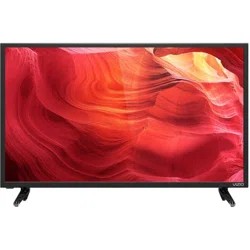Documents: Go to download!
- User Manual - (English)
- Quick Start Guide - (English)
- On-Screen Menu
- Setting timers
- Using the Network Connection Menu
- Setting Up Channels
- Listening to Alternate Audio
- Setting Up Closed Captioning
- Changing the TV Settings
- Using the USB Media Player
- VIZIO Internet Apps Plus 6 ® (V.I.A. Plus)
- TROUBLESHOOTING
Table of contents
Full-Array LED Smart TV User Manual
On-Screen Menu
Your TV features an easy-to-use on-screen menu.
To open the on-screen menu, press the MENU button on the remote.
You can also open the on-screen menu by pressing the VIA button and selecting HDTV Settings from the VIA Dock, then pressing OK.
From this menu, you can:
|  |
NAVIGATING THE ON-SCREEN MENU
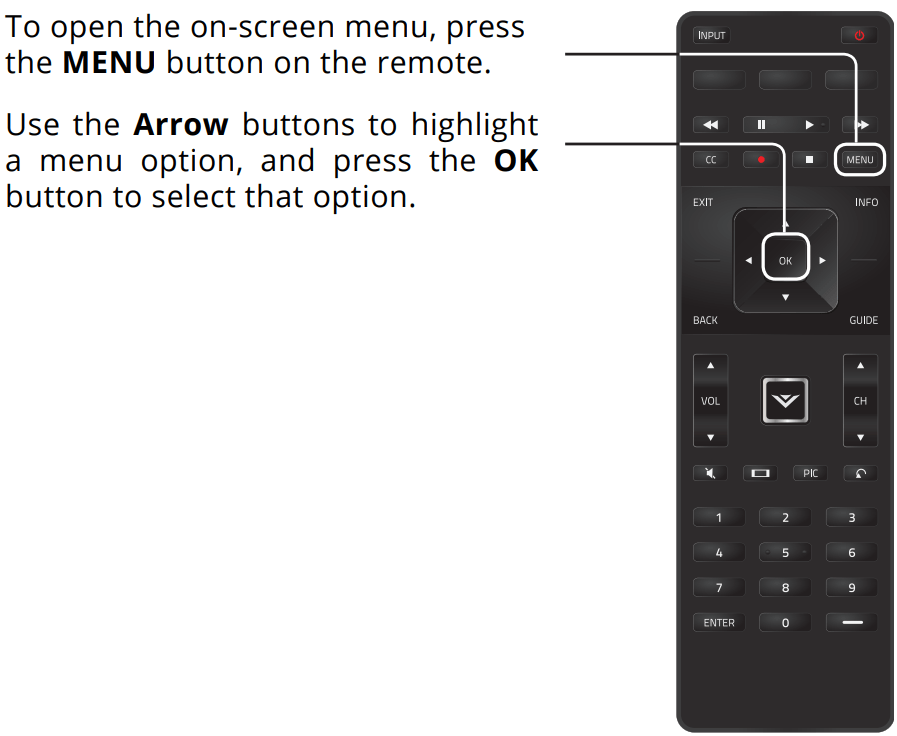
TIPS: While navigating the on-screen menu, you can press the BACK button at any time to return to the previous menu screen. The EXIT button will close the on-screen menu.
CHANGING THE INPUT SOURCE
External devices such as DVD players, Blu-ray Players, and video game consoles can be connected to your TV. To use one of these devices with your TV, you must first change the input source using the Input menu.
To change the input source:
The selected input is displayed. | 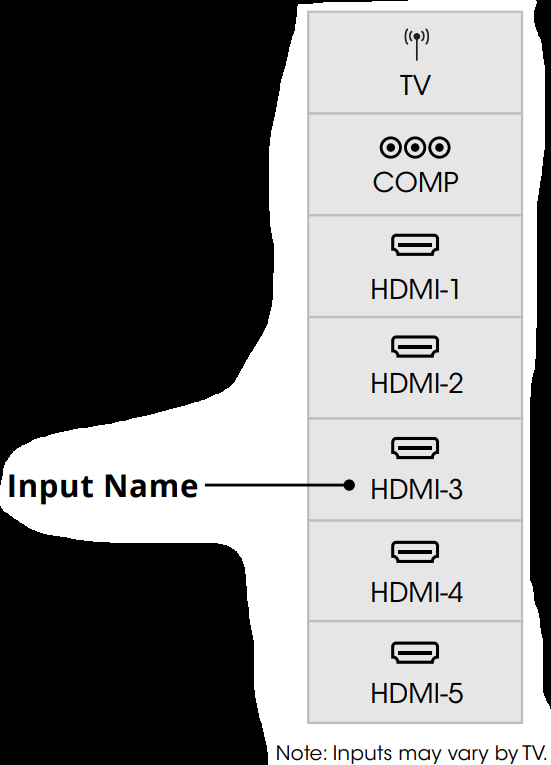 |
CHANGING THE SCREEN ASPECT RATIO
The TV can display images in four different modes: Normal, Panoramic, Wide, and Zoom. Each mode displays the picture differently.
Some programs have black bars on the top or sides of the picture so that the picture keeps its original shape. Examples include wide-screen movies and older television programs.
To change the screen aspect ratio:
- Press the WIDE button on the remote.
- Use the Arrow buttons to highlight the aspect ratio you wish to view and press OK
- Normal preserves the content’s original aspect ratio and size.
- Standard Definition (480i and p—old TV programs) - Since the 4:3 aspect ratio is not large enough to fill the TV’s screen, black bars are added to the left and right of the display image.
- 720p and 720i HD - Fills a 720p or 1080p screen.
- 1080p and 1080i HD - Fills a 720p or 1080p screen.
- Panoramic stretches a 4:3 aspect ratio picture to the left and right edges of the screen. The center of the image is not stretched, but the sides of the image are extremely stretched. If you are watching widescreen (1.85:1 or 2.35:1) content with black bars on the top and bottom, the black bars will still appear on the top and bottom of the display image.
- Standard Definition (480i and 480p) - Fills the screen from the left to right edges.
- 720p and 720i - Not available.
- 1080p and 1080i - Not available
- Wide stretches a 4:3 aspect ratio picture to the edges of the screen. Since the picture is being stretched, the display image may appear distorted—figures appear short and fat. If the program is already formatted for widescreen viewing or 2.35:1), then black bars will appear on the top and bottom of the display image.
- Zoom expands images evenly in all directions (33% taller and 33% wider) with black bars to fit the screen. A 720p image will fill a 1080p screen.
- Standard Definition - Not available.
- 720p and 720i HD - Fills a 1080p screen
- 1080p and 1080i - Not available
VIEWING VIDEO WITH THE MENU OPEN
When the on-screen menu opens, it covers the left-hand portion of the picture. The picture can be displayed in three different ways:
- Viewport - The entire picture is resized to fit into the space to the right of the menu
- Overlay - The picture stays in its normal postion and the menu covers the left-hand portion of the picture. (The picture is full-sized)
- Centered Overlay - The picture is full-sized and centered in the area next to the menu, so that the right and left edges are cut off.
|  |

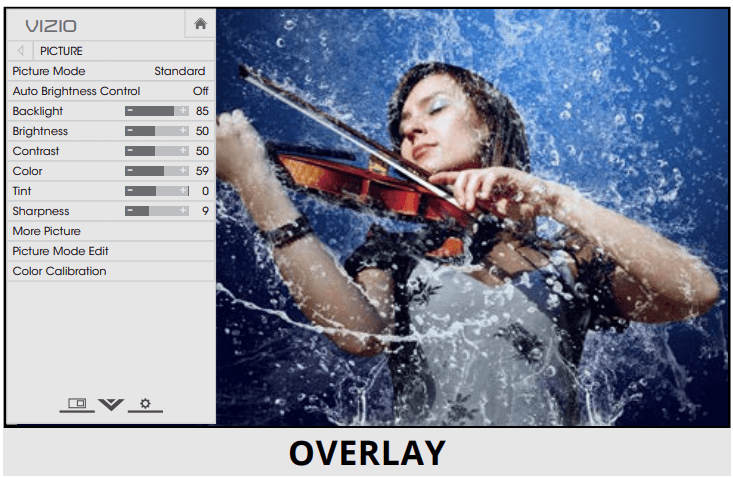

ADJUSTING THE PICTURE SETTINGS
Your TV display can be adjusted to suit your preferences and viewing conditions.
To adjust the picture settings:
- Press the MENU button on the remote. The on-screen menu is displayed.
- Use the Arrow buttons on the remote to highlight Picture and press OK. The PICTURE menu is displayed.
- Use the Arrow buttons on the remote to highlight Picture Mode, then use the Left/Right Arrow buttons to change the picture mode:
- Standard mode sets the picture settings to the default settings.
- Calibrated mode sets the picture settings to values ideal for watching TV in a brightly-lit room.
- Calibrated Dark mode sets the picture settings to values ideal for watching TV in a dark room.
- Vivid mode sets the picture settings to values that produce a brighter, more vivid picture.
- Game mode reduces throughput delays and optimizes the picture settings for displaying game console output.
- Computer mode optimizes the picture settings for displaying computer output.
- To manually change each of the picture settings, use the Up/Down Arrow buttons on the remote to highlight that picture setting, then use the Left/Right Arrow buttons to adjust the setting:
- Auto Brightness Control - The auto brightness control detects the light levels in the room and automatically adjusts the backlight for the best picture. Select Off, Low, Medium, or High.
- Backlight - Adjusts the LED brightness to affect the overall brilliance of the picture. Backlight cannot be adjusted when starting from some picture modes.
- Brightness - Adjusts the black level of the picture. When this setting is too low, the picture may be too dark to distinguish details. When this setting is too high, the picture may appear faded or washed out.
- Contrast - Adjusts the white level of the picture. When this setting is too low, the picture may appear dark. When this setting is too high, the picture may appear faded or washed out. If the setting is too high or too low, detail may be difficult to distinguish in dark or bright areas of the picture.
- Color - Adjusts the intensity of the picture colors.
- Tint - Adjusts the hue of the picture. This setting is useful in adjusting the flesh tones in the picture. If flesh appears too orange, reduce the level of color before adjusting tint.
- Sharpness - Adjusts the edge sharpness of picture elements. It can be used to sharpen non-HD (high definition) content; however, it will not produce detail that does not otherwise exist.
- When you have finished adjusting the picture settings, press the EXIT button on the remote.
Adjusting More Picture Settings
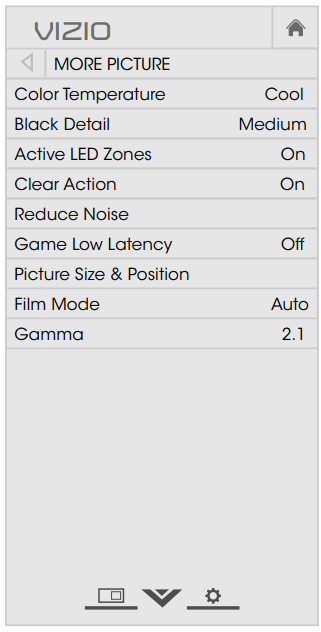
To adjust more picture settings:
- From the PICTURE menu, use the Arrow buttons to highlight More Picture, and then press OK.
- Use the Arrow buttons to highlight the setting you wish to adjust, then press the Left/Right Arrow buttons to change the setting:
- Color Temperature - See Adjusting the Color Temperature.
- Black Detail - Adjusts the average brightness of the picture to compensate for large areas of brightness. Select Off, Low, Medium, or High.
- Active LED Zones - Dynamically improves the contrast ratio of the picture by adjusting the backlight. The adjustment is controlled by the content on the screen. Select On or Off.
- Clear Action - Reduces blur in scenes with fast action. Some sensitive viewers may notice flicker. Select On or Off.
- Reduce Noise — Opens a sub-menu with two settings:
- Reduce Signal Noise* - Diminishes artifacts in the image caused by the digitizing of image motion content. Select Off, Low, Medium, or High.
- Reduce Block Noise - Reduces pixelation and distortion for mpeg files. Select Off, Low, Medium, or High.
- Game Low Latency - Select On to reduce video delay (lag) when gaming.
- Picture Size & Position - Highlight Picture Size & Position and press OK. The PICTURE SIZE & POSITION menu is displayed.
- Picture Size: Increase or decrease the vertical and horizontal size of the displayed picture. Use the Left/Right Arrow buttons to adjust the horizontal size of the displayed picture. Use the Up/Down Arrow buttons to adjust the vertical size of the displayed picture. Press the OK button when you are finished.
- Picture Position: Adjust the vertical and horizontal positions of the picture to ensure the image is centered and completely fills the screen. Use the Left/Right Arrow buttons to adjust the horizontal position of the displayed picture. Use the Up/Down Arrow buttons to adjust the vertical position of the displayed picture. Press the OK button when you are finished.
- Film Mode - Optimizes the picture for watching film. Select Auto or Off.
- Gamma - Set the shape of the Gamma curve. Use lower Gamma values for bright room conditions, and higher values when it’s dark.
- When you have finished adjusting More Picture Settings, press the EXIT button on the remote
Adjusting the Color Temperature
To adjust the color temperature:
| 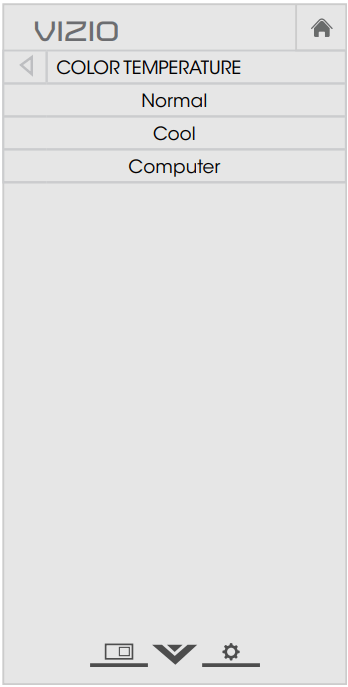 |
Adjusting the color temperature changes the white balance of the picture.
Adjusting the Picture Mode Edit Settings
Picture Mode Edit Settings allow you to make precise adjustments to the picture and to create picture modes to save groups of picture settings.
To adjust the Picture Mode Edit settings:
- From the PICTURE menu, use the Arrow buttons to highlight Picture Mode Edit, and then press OK. The PICTURE MODE EDIT menu is displayed.
- Use the Arrow buttons to highlight the setting you wish to adjust, then press OK to change the setting:
- Save Picture Mode - Save a custom picture mode.
- Lock Picture Mode - Prevent changes to custom picture modes.
- Unlock Picture Mode - Allow changes to custom picture modes. (Available after a custom picture mode is locked)
- Delete Picture Mode - Delete a custom picture mode. Inputs assigned to that custom picture mode will be set to Calibrated picture mode. (Available after a custom picture mode is saved)
- Reset Picture Mode - Reset the picture mode settings to factory default values.
Saving a Custom Picture Mode
Custom picture modes allow you to save a group of custom settings for various viewing conditions and video sources.
- Changes made while on any preset picture mode will add an asterisk on the top right corner of the preset mode.
- The custom picture mode is not automatically saved.
To save a custom picture mode:
| 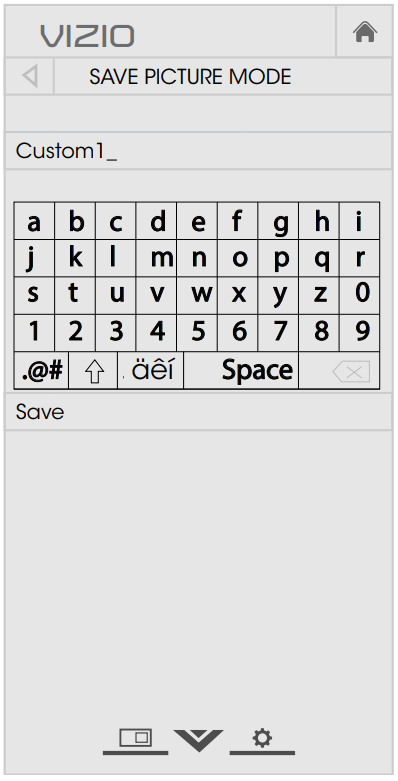 |
Locking/Unlocking a Custom Picture Mode
Custom picture modes can be locked/unlocked with a unique PIN to prevent accidental changes to their settings.
To lock all custom picture modes:
| 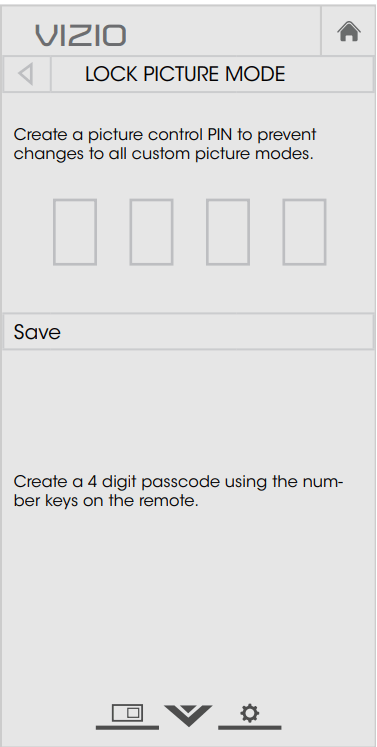 |
To unlock all custom picture modes:
- From the PICTURE MODE EDIT menu, use the Arrow buttons to highlight Unlock Picture Mode, and then press OK. The UNLOCK PICTURE MODE menu is displayed.
- Use the Number Pad on your remote to enter your 4-digit PIN.
- Make any desired changes to the picture modes.
- Relock the picture modes, if desired. You must create a new digit PIN.
- Press the EXIT button to exit the menu screens
Deleting a Custom Picture Mode
Custom picture modes that are no longer needed can be deleted.
To delete a custom picture mode:
- From the PICTURE MODE EDIT menu, use the Arrow buttons to highlight Delete Picture Mode, and then press OK. The DELETE PICTURE MODE window is displayed.
- Use the Left/Right Arrow buttons to highlight Delete and press
- Press the EXIT button to exit the menu screens.
Resetting a Picture Mode
A preset picture mode that has been edited can be restored to the factory default settings.
To reset a customized preset picture mode:
- From the PICTURE MODE EDIT menu, use the Arrow buttons to highlight Reset Picture Mode, and then press OK. The RESET PICTURE MODE window is displayed.
- Use the Left/Right Arrow buttons to highlight Reset and press OK
- Press the EXIT button to exit the menu screens.
ADJUSTING THE AUDIO SETTINGS
To adjust the audio settings:
|  |
- TV Speakers - Turns the built-in speakers On or Off.
- Surround Sound - Surround sound uses DTS TruSurround™ to deliver an immersive surround sound experience from the TV’s internal speakers. TruSurround completes the entertainment experience by providing deep, rich bass and by delivering crisp details and clear, intelligible dialog. Select On or Off.
- Volume Leveling - Volume leveling uses DTS TruVolume™ to maintain consistent volume levels during transitions between program content, AV formats, and input sources. Select On or Off. In a few cases, volume leveling may artificially suppress volume increases, making it difficult to hear dialog or flattening sudden noises. If this occurs, turn volume leveling off.
- Balance - Adjusts the loudness of the audio output from the left and right speakers.
- Lip Sync - Adjusts the synchronization between the display image and the accompanying audio track.
- Digital Audio Out - Changes the type of processing for digital audio out and HDMI ARC output when connected to a home theater audio system. Select PCM or Bitstream.
- Analog Audio Out - Sets the volume control properties for the RCA connector when connected to a home theater audio system. Select Variable if you are controlling the volume with the TV’s volume controls, or select Fixed if an external audio device (sound bar or AV receiver) will control the volume.
- Equalizer - Adjusts the boost or attenuation of different frequencies using either preset or custom settings.
- Delete Audio Mode - Deletes a custom audio mode created using the Equalizer Settings.
- When you have finished adjusting the audio settings, press the EXIT button on the remote.
- Lip Sync - Adjusts the synchronization between the display image and the accompanying audio track.
- Digital Audio Out - Changes the type of processing for digital audio out and HDMI ARC output when connected to a home theater audio system. Select PCM or Bitstream.
- Analog Audio Out - Sets the volume control properties for the RCA connector when connected to a home theater audio system. Select Variable if you are controlling the volume with the TV’s volume controls, or select Fixed if an external audio device (sound bar or AV receiver) will control the volume.
- Equalizer - Adjusts the boost or attenuation of different frequencies using either preset or custom settings.
- Delete Audio Mode - Deletes a custom audio mode created using the Equalizer Settings.
4. When you have finished adjusting the audio settings, press the EXIT button on the remote.
Changing the Equalizer Settings
The graphic equalizer has several pre-set modes and allows you to create one custom mode.
To select a pre-set audio mode:
- Press the MENU button on the remote. The on-screen menu is displayed.
- Use the Arrow buttons on the remote to highlight Audio and press OK. The AUDIO menu is displayed.
- Use the Arrow buttons to highlight Equalizer and press OK. The Audio Mode and equalizer settings screen appears.
- Use the Left and Right Arrow buttons to select an audio mode. The equalizer bars change to reflect the mode.
- Press the EXIT button on the remote.
To create, modify, or replace the single custom equalizer setting:
- Press the MENU button on the remote. The on-screen menu is displayed.
- Use the Arrow buttons on the remote to highlight Audio and press OK. The AUDIO menu is displayed.
- Use the Arrow buttons to highlight Equalizer and press OK. TheAu dio Mode and equalizer settings screen appears.
- Use the Left and Right Arrow buttons to select any audio mode as a starting point.
- Use the Arrow buttons to highlight a frequency and then press OK.
- Use the Up and Down Arrow buttons to adjust the boost (up) and attenuation (down) for the frequency.
- Use the Left and Right Arrow buttons to select another frequency, if desired, and adjust it.
- Press the EXIT button on the remote.
Deleting the Custom Audio Mode
To delete the custom audio mode that has been created:
- Press the MENU button on the remote. The on-screen menu is displayed.
- Use the Arrow buttons on the remote to highlight Audio and press OK. The AUDIO menu is displayed.
- Use the Arrow buttons to highlight Delete Audio Mode and press OK. The TV displays, “To delete the user created custom audio mode, select the Delete button.”
- Highlight Delete and press OK.
- Press the EXIT button on the remote.
Setting timers
Setting the Sleep Timer
When activated, the TV’s sleep timer will turn the TV off after a set period of time.
| 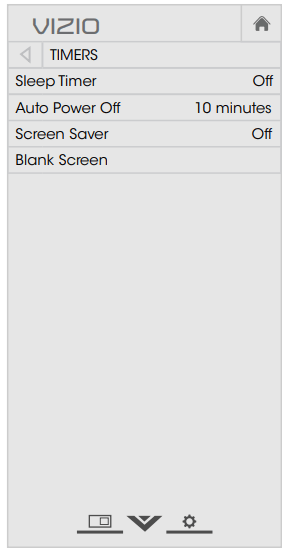 |
Setting the Auto Power Off Feature
To help save energy, your TV is set by default to turn off after minutes without a video or audio signal. This feature can be deactivated.
To set the Auto Power Off feature:
- From the TIMERS menu, use the Up/Down Arrow buttons on the remote to highlight Auto Power Off.
- Use the Left/Right Arrow buttons on the remote to change whether the TV will turn off. If you don’t want the TV to turn off when there is no signal, change the setting to Off. Otherwise, select 10 minutes.
- When you have finished setting the auto power off time, press the EXIT button on the remote.
Enabling the Screen Saver
If there is no on-screen content or static content when audio is streaming, the backlight is turned off, saving energy. You can set the time before the screen saver begins.
To set the Screen Saver:
- From the TIMERS menu, use the Up/Down Arrow buttons on the remote to highlight Screen Saver.
- Use the Left/Right Arrow buttons on the remote to change the time before the screen saver begins. If you don’t want the screen saver to be active, change the setting to Off. Otherwise, select 2, 10, or 20 minutes.
- When you have finished setting the screen saver time, press the EXIT button on the remote.
NOTE To Exit the Screen Saver Press any button other than the Volume and Mute buttons on the remote to exit the screen saver.
Blanking the Screen
You can blank the screen while there is audio streaming. This feature helps save energy and the life of the screen.
To blank the screen:
- From the TIMERS menu, use the Up/Down Arrow buttons on the remote to highlight Blank Screen and press OK.
NOTE To Exit the Blank Screen Press any button other than the Volume and Mute buttons on the remote to exit the blank screen.
Using the Network Connection Menu
Connecting to a Wireless Network
Your TV is Internet-ready, featuring both an Ethernet port and built-in high-speed Wireless-N.
Connecting to a Wireless Network
To connect to a wireless network whose network name (SSID) is being broadcast:
WARNING If your TV is connected to a network with an Ethernet cable, you will not see the wireless network connection menu. You must disconnect the Ethernet cable to set up a wireless network connection.
| 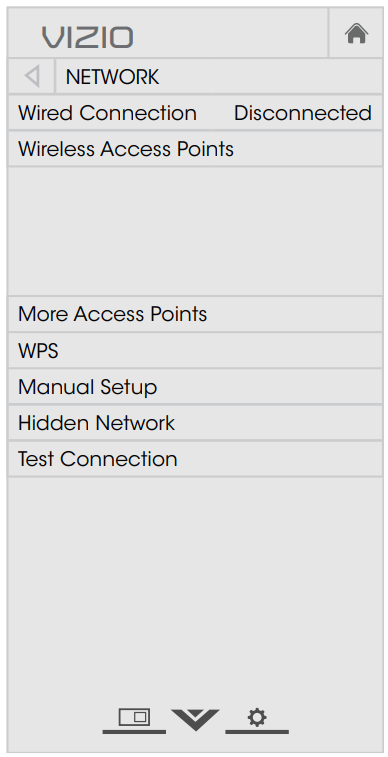 |
Changing the Manual Setup Settings
Advanced users can fine-tune the network settings using the Manual Setup feature.
To change advanced network settings:
| 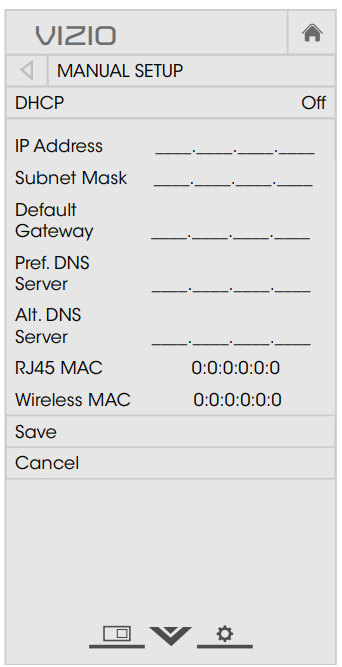 |
Finding MAC Addresses for Network Setup
The security settings on your router may require you to enter the
TV's MAC address in the router's settings.
To find the TV's MAC address:
- From the NETWORK menu, highlight Manual Setup and press OK. The MANUAL SETUP menu is displayed.
- Find the MAC address for the TV at the bottom of the list. The MAC addresses for the connections in use are displayed:
- RJ45 MAC - The Ethernet or RJ45 MAC address may be needed to set up your network when you have connected the TV to your network with an Ethernet (Cat 5) cable.
- Wireless MAC - The Wireless (WiFi) MAC address may be needed to connect your TV to your network with WiFi.
Connecting to a Hidden Network
To connect to a wireless network whose network name (SSID) is not being broadcast:
| 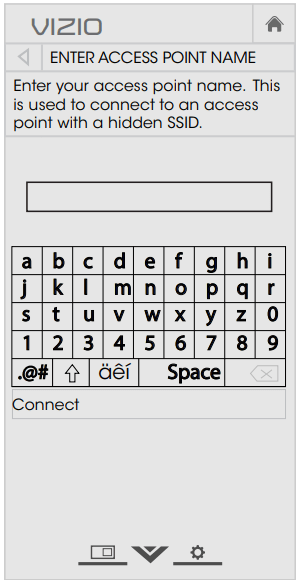 |
Testing Your Network Connection
To test your network connection:
- From the NETWORK menu, highlight Test Connection and press OK.
- The TEST CONNECTION screen displays the connection method, network name, signal strength, and download speed of your network connection.
- Press the EXIT button on the remote.
Setting Up Channels
Selecting a Channel Source
| 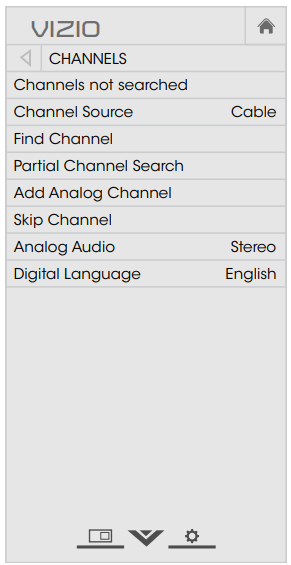 |
Scanning for Channels
Selecting a Channel Source
Select the type of tuner input you will be using. You can select either Antenna (Over-the-air) or Cable (Out-of-the-wall) connections.
- From the CHANNELS menu, highlight Channel Source and press OK. The CHANNEL SOURCE menu displays.
- Highlight Antenna or Cable and press OK. Press EXIT.
Scanning for Channels
The TV may need to scan for channels before it can display programs and their associated information. A channel scan is required for free over-the-air channels (using an antenna) and cable channels from an out-of-the-wall connection (without a cable box). Moving the TV to an area with different channels requires the TV to scan for channels again.
To perform an Auto Channel Scan:
If the channel scan is cancelled, the channels that were already discovered are retained. A new channel scan will clear all channels. | 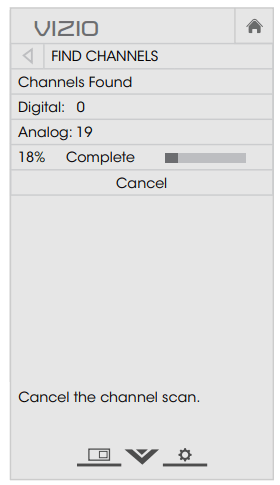 |
Adding New Channels
Occasionally, you may need to add a new range of channels or add a new analog channel. You can do this by using the Partial
Channel Search and Add Analog Channel options. This is quicker than scanning all possible channels.
To add a range of new channels:
- From the CHANNELS menu, highlight Partial Channel Search, and press OK. The PARTIAL CHANNEL SEARCH menu is displayed.
- Highlight Scan Mode and select the type of channel you are adding: Analog, Digital, or Analog/Digital.
- Highlight From Channel and enter the channel where you want to begin the scan. (Use the Left Arrow button to backspace. Use the Number Pad on the remote to enter the channel.)
- Highlight To Channel and enter the channel where you want to end the scan. (Use the Left Arrow button to backspace. Use the Number Pad on the remote to enter the channel.)
- Highlight Start and press OK. The partial channel search begins.
- Wait until the partial channel search is 100% complete. Highlight Done and press OK.
- Press the EXIT button on the remote.
To add a single new analog channel:
| 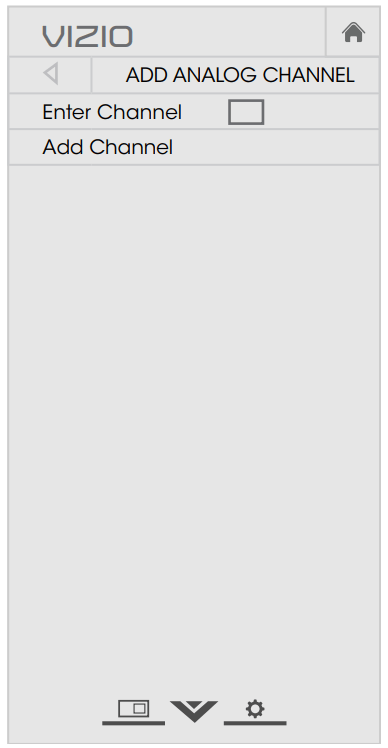 |
Skipping Channels
After a channel scan is completed, you may find that some channels are too weak to watch comfortably. There may also be some channels you do not want to view. You can remove these channels from the TV’s memory with the Skip Channel feature.
WARNING Channels that have been removed with the Skip Channel feature can still be viewed if the channel is entered using the Number Pad. If you wish to completely block a channel from being viewed, use the parental controls. See Locking and Unlocking Channels
To remove a channel:
| 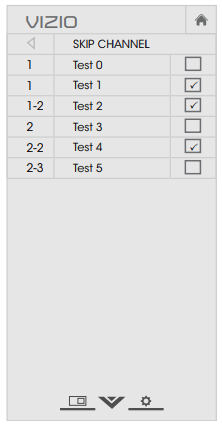 |
Listening to Alternate Audio
Changing the Analog Audio Language
Some analog over-the-air (free) and cable channels broadcast programs in more than one language. The TV’s Analog Audio feature allows you to listen to audio in an alternate language using Secondary Audio Programming (SAP).
WARNING Not all programs are broadcast in SAP. The Analog Audio Language feature only works when the program being viewed is being broadcast with Secondary Audio Programming.
To use the Analog Audio feature:
| 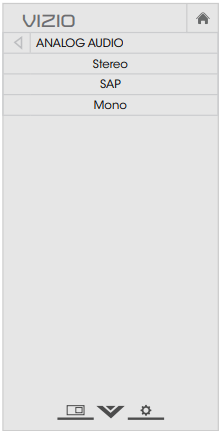 |
To use the Digital Language feature:
|  |
Setting Up Closed Captioning
Your TV can display closed captions for programs that include them. Closed captions display a transcription of a program’s dialogue.
NOTE
If the program you are viewing is not being broadcast with closed captions, the TV will not display them.
The Closed Captions menu does not appear when an HDMI input is selected.
To activate or deactivate closed captions:
|  |
Changing the Appearance of Digital Closed Captions
Digital closed captions can be displayed according to your preference.
| 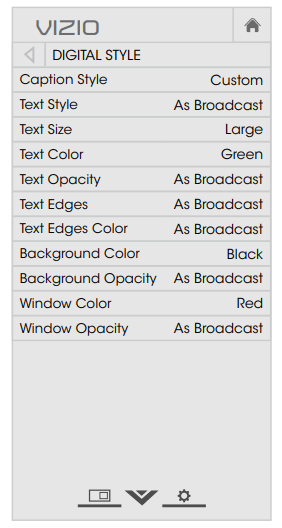 |
Typical choices include:
- Opaque background, transparent window—Only a strip of background appears behind the text, expanding as the text appears. This is the typical "As Broadcast" mode.
- Opaque background and window in the same color—When text appears, the entire line fills with color at once.
In the example below, the closed caption text is green, the background is black, and the window is red.
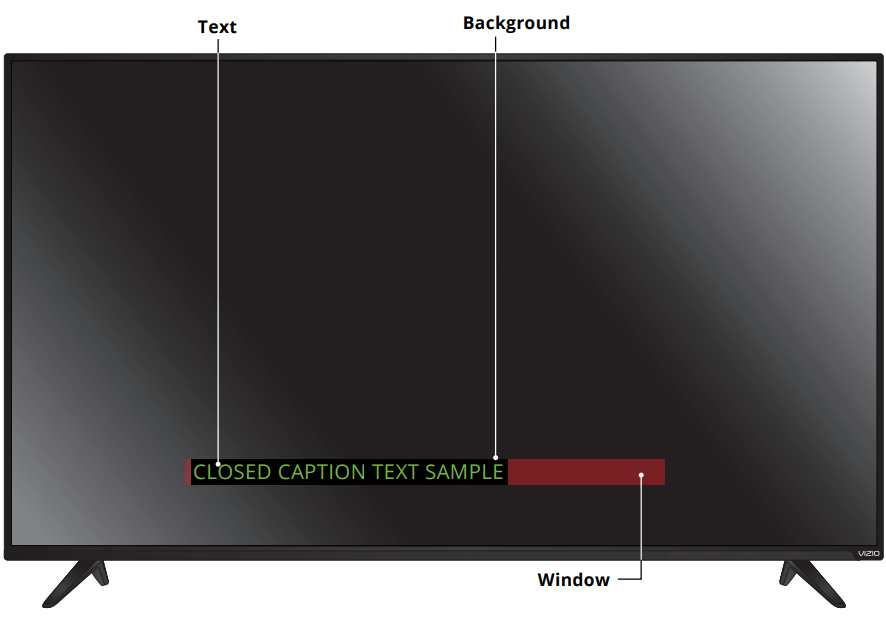
Changing the TV Settings
Viewing System Information
To view technical data and status information about your TV and network connection:
- Press the MENU button on the remote. The on-screen menu is displayed.
- Use the Arrow buttons on the remote to highlight System and press OK. The SYSTEM menu is displayed.
- Highlight System Information and press OK.
- Use the Up/Down Arrow buttons to scroll through the system information.
- When you are finished reviewing the system information, press the EXIT button on the remote.
Changing the On-Screen Menu Language
Your TV can display the on-screen menu in different languages.
To change the on-screen menu language:
| 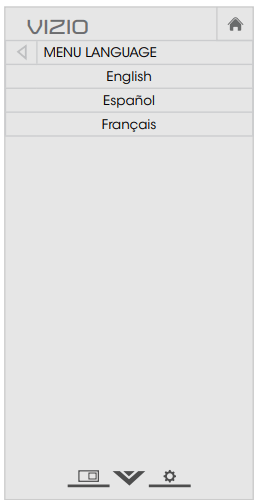 |
Setting the Time and Local Settings
To ensure the correct time is displayed when you press the INFO button, set the TV’s time zone:
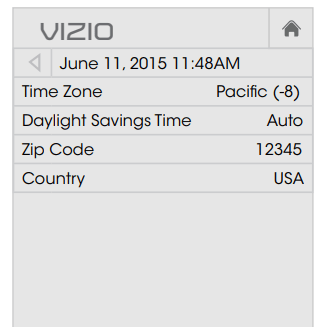
- Press the MENU button on the remote. The on-screen menu is displayed.
- Use the Arrow buttons on the remote to highlight System and press OK. The SYSTEM menu is displayed.
- Use the Arrow buttons on the remote to highlight Time & Local Settings and press OK. The menu headed by the local date and time is displayed.
- Highlight Time Zone and press OK. The TIME ZONE menu is displayed.
- Highlight your time zone and press OK.
- Highlight Daylight Saving Time and press OK. The DAYLIGHT SAVING TIME menu is displayed. Choose On if it is currently Daylight Savings Time, Off if it is Standard Time, or Auto to have the system automatically detect Daylight Savings Settings.
- If you are in the United States, highlight Zip Code. Enter your Zip code using the keypad on the remote, then press OK. Zip codes are often used by V.I.A. Plus Apps to give you the most accurate location-based information, such as weather or news.
- Highlight Country and press OK. The COUNTRY menu is displayed.
- Highlight your country and press OK.
- Press the EXIT button on the remote.
Using the Parental Controls
The TV’s parental controls allow you to prevent the TV from displaying certain channels or programs without a password.
The Parental Controls menu only appears when:
- You are using the tuner to receive your TV signals, such as when you are using an antenna for Over-the-Air signals or when connected to cable TV directly from the wall (no cable box).
- You have a device connected using a composite video cable or a coaxial cable, such as a VCR, satellite or cable box, or VR.
NOTE Other devices have their own parental control settings
Accessing the Parental Controls Menu
To access the Parental Controls menu:
- Press the MENU button on the remote. The on-screen menu is displayed.
- Use the Arrow buttons on the remote to highlight System and press OK. The SYSTEM menu is displayed.
- Use the Arrow buttons on the remote to highlight Parental Controls and press OK.
- Enter your parental PIN. If you have not set a PIN, enter the default, 0000. The PARENTAL CONTROLS menu is displayed.
Enabling or Disabling Program Ratings
To manage program content according to its rating, you must enable the Program Rating feature.
To enable or disable the Program Rating feature:
- From the PARENTAL CONTROLS menu, highlight Locks and press OK. The LOCKS menu is displayed.
- Select On or Off and press OK.
Locking and Unlocking Channels
is a good way to prevent children from viewing inappropriate material.
To lock or unlock a channel:
- From the PARENTAL CONTROLS menu, highlight Channel Locks and press OK. The CHANNEL LOCKS menu is displayed.
- Highlight the channel you want to lock or unlock and press OK.
- When a channel is locked, the Lock icon
 appears locked. The channel is not accessible unless the parental PIN is entered.
appears locked. The channel is not accessible unless the parental PIN is entered. - When a channel is unlocked, the Lock icon
 appears unlocked. The channel is accessible.
appears unlocked. The channel is accessible.
Blocking and Unblocking Content by Rating
A channel may sometimes broadcast programs that are meant for children, and at other times broadcast programs that are meant for mature audiences. You may not want to block the channel completely using a channel lock, but you may wish to block certain programs from being viewed.
When this is the case, you can use the TV’s Rating Block feature to block content based on its rating.
NOTE For a list of content ratings and their definitions, visit www.tvguidelines.org
To block or unblock content by its rating:
- From the PARENTAL CONTROLS menu, highlight the content type you want to adjust and press OK:
- USA TV - USA television program broadcasts.
- USA Movie - USA movie broadcasts.
- Canadian English - Canadian English television program broadcasts.
- Canadian French - Canadian French television program broadcasts.
- For each rating type you want to block or unblock, use the Up/Down and Left/Right Arrow buttons on the remote to highlight the rating type and press OK.
- When the rating type is blocked, the Lock icon
 appears locked. Content with this rating and all higher ratings cannot be viewed.
appears locked. Content with this rating and all higher ratings cannot be viewed. - When the rating type is unblocked, the Lock icon
 appears unlocked. Content with this rating and all lower ratings can be viewed.
appears unlocked. Content with this rating and all lower ratings can be viewed.- If you want to block all unrated content, highlight Block Unrated Shows and use the Arrow buttons on the remote to select On.
- When you are finished adjusting the rating level blocks, press the EXIT button on the remote.
Changing the Parental Control PIN
If you use the parental controls, you should change the PIN to prevent children from accessing inappropriate material.
To change the parental control PIN:
- From the PARENTAL CONTROLS menu, highlight Change PIN and press OK. The CHANGE PIN menu is displayed.
- In the NEW PIN field, use the Number Pad on the remote to enter your new 4-digit parental control PIN.
- In the CONFIRM PIN field, use the Number Pad on the remote to re-enter your new 4-digit parental control PIN.
- Write down your new parental control PIN and save it in a secure location.
- Press the EXIT button on the remote.
Resetting the Content Locks
To reset the content locks to the factory-default settings:
- From the PARENTAL CONTROLS menu, highlight Reset Locks and press OK. The TV displays, “Select Reset to restore Parental Controls to factory defaults.”
- Highlight Reset and press OK.
Changing the View Mode Settings
You can resize the video content to fit while the menu is open.
To change the view mode settings:
| 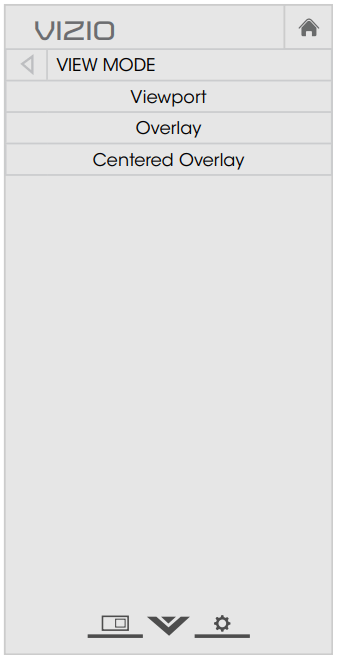 |
Using the USB Media Player
The USB Media Player allows you to connect a USB thumb drive to your TV and play music, video, or photos.
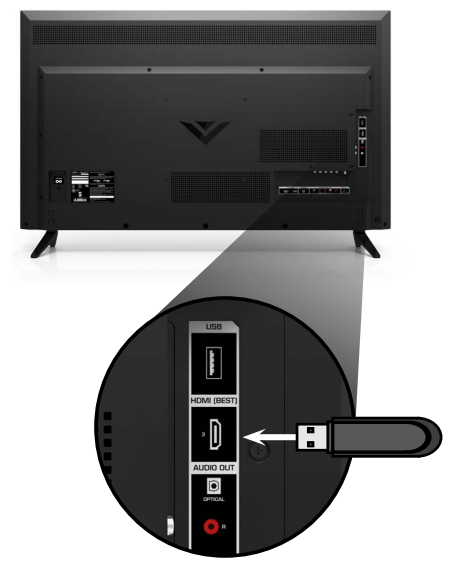
Preparing Your USB Drive to Play USB Media
To play USB media, you must first save your files onto a USB thumb drive:
- The USB thumb drive must be formatted as FAT32.
- Files on the USB thumb drive must end in a supported file extension (.mp3, .jpg, etc.).
- The player is not designed to play media from external hard drives, MP3 players, cameras, or smartphones
Playing USB Media
To play your USB media:
- Connect your USB thumb drive to the USB port on the side of the TV.
- Press the V button on the remote.
- Use the Arrow buttons to highlight the Multimedia app in the V.I.A. Plus Dock and press OK. (The highlighted App is in the center of the dock.)
- Use the Arrow buttons to highlight the USB drive from the list and press OK.
- Use the Arrow buttons to highlight the type of media to display (Music, Video, or Photo) and press OK.
- Use the Arrow buttons to highlight the file you want to display. Press OK. Music or video files play, photos display
NOTE You can display your photos in fullscreen. Select the photo, press OK, then highlight Fullscreen and press OK.
Removing the USB Drive from the TV
To safely remove your USB drive from the TV:
- Turn off the TV.
- Disconnect your USB thumb drive from the USB port on the side of the TV.
WARNING Do not remove the USB thumb drive while the TV is on. Doing so may damage the drive.
VIZIO Internet Apps Plus 6 ® (V.I.A. Plus)
USING THE V.I.A. PLUS APP DOCK
The V.I.A. Plus App Dock is where all of your V.I.A. Apps are accessed.
To launch an App from the Dock:
| 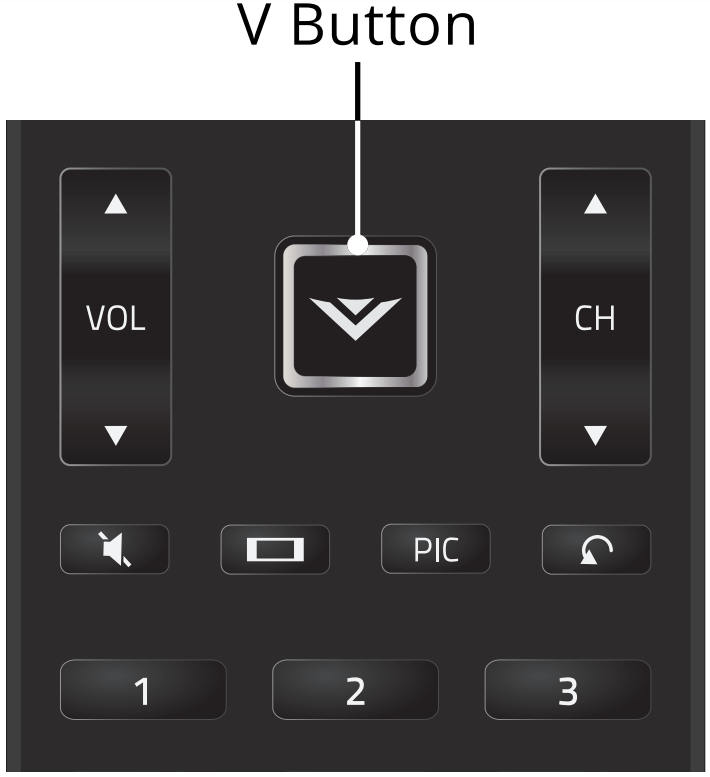 |
Using the App Launcher Keys
Using the App Launcher Keys on the remote launch the apps pictured on the buttons. Pressing the App Launcher Key will also turn the TV on if it is off). The specific apps on the App Launcher keys vary from model to model. | 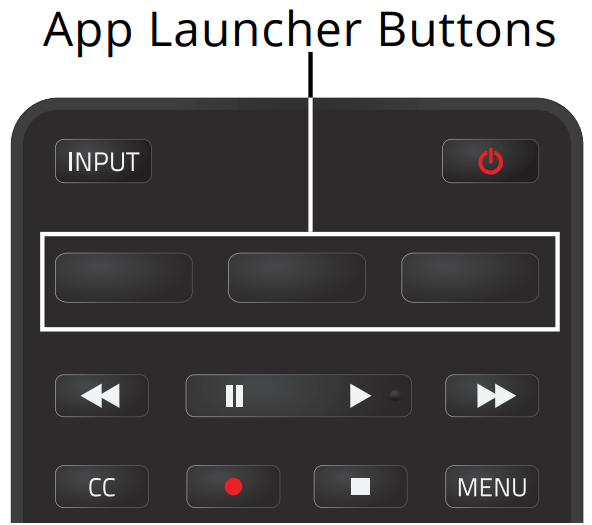 |
USING THE FULLSCREEN V.I.A. APPS WINDOW
The Fullscreen V.I.A. Plus Apps window allows you to add and store Apps. The Apps on the first page are displayed in the Dock and Apps on additional pages can be moved to the Dock.
To open the Fullscreen V.I.A. Plus Apps Window:
- Press the V Button on the remote twice.
- Highlight an App by using the Arrow buttons on the remote.
- Press the OK button on the remote to launch the App.
- To exit from an open App or to close the App Dock, press the Exit button on the remote.
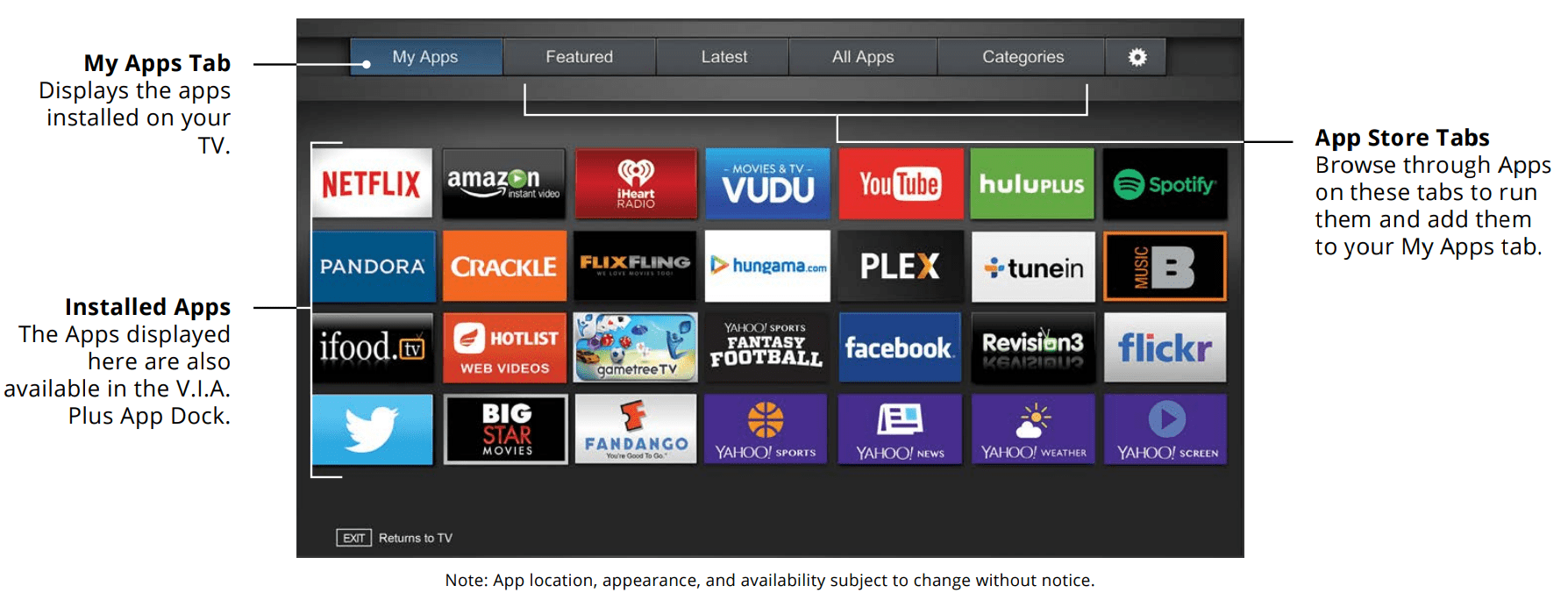
FULLSCREEN V.I.A. PLUS APPS WINDOW OVERVIEW
The Fullscreen V.I.A. Plus Apps Window allows you to add, delete and organize your Apps. The My Apps tab displays Apps that are already installed on your TV. The Apps on the first page are displayed in the V.I.A. Plus App Dock.
The following tabs are located at the top of your Fullscreen V.I.A. Plus Apps Window:
- My Apps: Displays apps that are installed on your TV.
- Featured: Displays apps that are recommended by Yahoo!
- Latest: Displays apps that were most recently added to the library of apps.
- All Apps: Displays every app that is available for download.
- Categories: Displays apps sorted into categories: Spotlight,
- Yahoo!, Weather, News and Finance, Movies and TV, Photos and Video, Sports, Music, Social, Information, Fun and Games, Shopping, and Local TV.
- Settings (
 ): Displays App software information and development settings.
): Displays App software information and development settings.
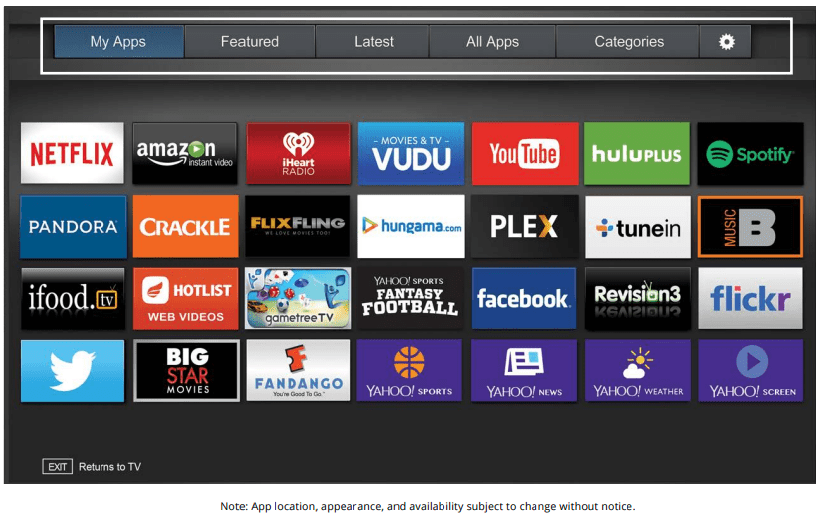
CUSTOMIZING THE V.I.A. PLUS APPS WINDOW
You can add, delete, and move apps around on your My Apps tab for a custom look and feel.
Adding an App to the My Apps Tab
To add an app to your TV:
- Use the Arrow buttons on the remote to highlight one of the App Store tabs (Featured, Latest, All Apps, or Categories).
- Use the Arrow buttons to highlight the app you wish to add.
- Press and hold the OK button until [App Name] has been added to your My Apps list appears.
Once the app has been installed, a star appears in the top right-hand corner of the app icon as shown below.
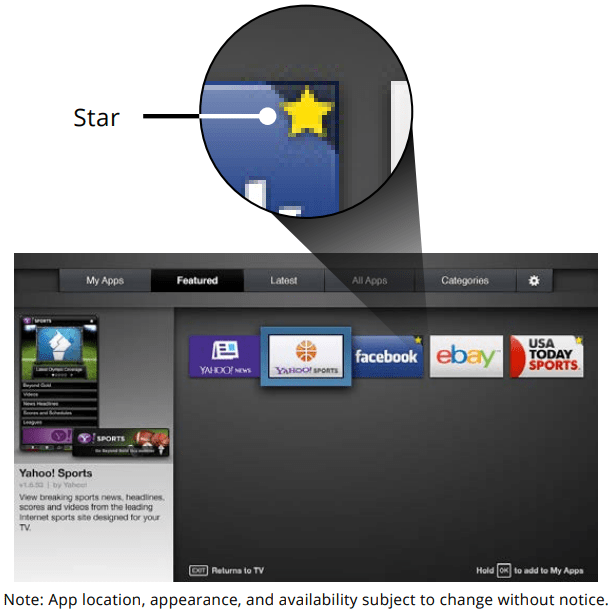
Deleting an App from the My Apps Tab
To delete an app from your TV:
- Use the Arrow buttons on the remote to highlight the App you wish to delete.
- Press and hold the OK button. The following options appear:
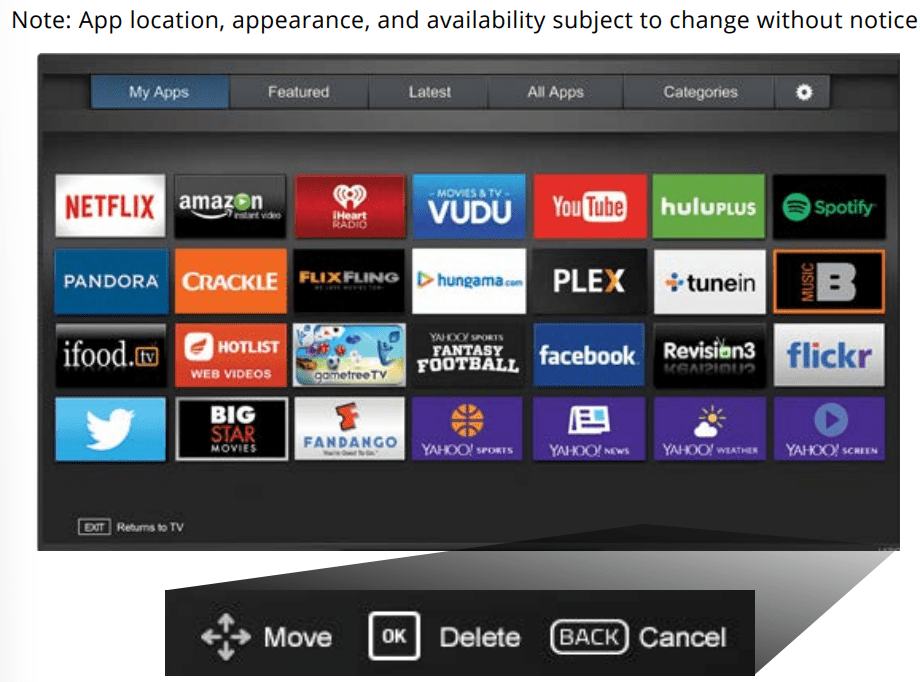
3. Press OK to delete the app. The following dialog box appears:
4. Use the Left/Right Arrow buttons to select Delete and press OK.
The App is removed from your My Apps tab.
Moving an App in My Apps
You can organize your Apps on your My Apps tab by moving them where you want.
To move the Apps on your My Apps tab:
- Use the Arrow buttons on the remote to highlight the app you wish to move.
- Press and hold the OK button. The following options appear:
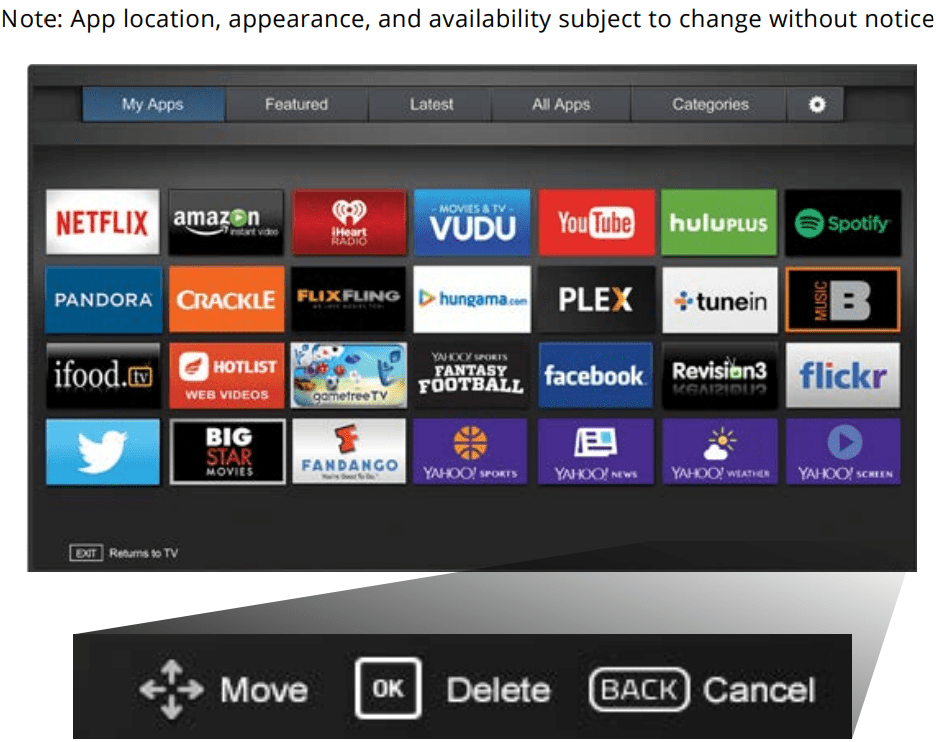
3. Use the Arrow buttons to move the app to the desired location and press OK to place the app. When you can move the app, it appears as shown below.

TROUBLESHOOTING
The remote is not responding.
- Make sure the batteries are properly inserted matching the - and + symbols.
- Replace the batteries with fresh ones.
The TV displays “No Signal.”
- Press the INPUT button on the remote control to select a different input source.
- If you are using cable TV or antenna connected directly to the TV, scan for channels. See Scanning for Channels.
There is no power.
- Ensure the TV is plugged into a working electrical outlet.
- Ensure the power cable is securely attached to the TV.
- Press the Power/Standby button on the remote or on the back of the TV to turn the TV on.
The power is on, but there is no image on the screen.
- Ensure all cables are securely attached to the TV.
- Ensure all devices are connected correctly. Devices differ; see your device’s user manual for details.
- Adjust Brightness, Contrast, or Backlight. See Adjusting the Picture Settings.
- Press the INPUT button on the remote to select a different input source.
There is no sound.
- Press Volume Up on the remote control.
- Press the MUTE button on the remote to ensure mute is off.
- Check the audio settings. See Adjusting the Audio Settings.
- Check the audio connections of external devices (Blu-ray player, game console, cable/satellite box) that are connected to the TV.
- If you are using an antenna, the signal strength of the channel may be low. Ensure your antenna is connected securely to the TV and move the antenna around the room or close to a window for the best signal.
The sound is flat or dialog is not audible.
- Turn off Volume Leveling.
The colors on the TV don’t look right.
- Adjust the Color and Tint settings in the Picture menu.
- Select a pre-set picture mode. VIZIO recommends selecting Calibrated.
- Check all cables to ensure they are securely attached.
The buttons on the remote aren’t working.
- Ensure you are only pressing one button at a time.
- Point the remote directly at the TV when pressing a button.
- Replace the remote batteries with new ones.
The image quality is not good.
- For the best image quality, view high-definition programs using digital sources. Connect your devices with HDMI cables.
- If you are using an antenna, the signal strength of the channel may be low. Ensure your antenna is connected securely to the TV and move the antenna around the room or close to a window for the best signal.
The picture is distorted.
- Move the TV away from electrical appliances, cars, and fluorescent lights.
- Ensure all cables are securely attached.
The display image does not cover the entire screen.
- If you are using TV, AV, or Component with 480i input, press the
 button on the remote to change the screen mode.
button on the remote to change the screen mode.
The TV has pixels (dots) that are always dark.
- Your FHD TV is precision-manufactured using an extremely high level of technology. However, sometimes pixels may not display correctly. These types of occurrences are inherent to this type of product and do not constitute a defective product.
The V.I.A. Plus Apps are not working
- Be sure your TV is connected to the internet. See Using the Network Connection Menu.
- Restart the App by pressing the EXIT button to close the App, then open the App.
- Reboot your TV by pressing the POWER button on the remote, then turn it back on.
I see “noise” or static on the screen.
- When your TV’s digital capabilities exceed a digital broadcast signal, the signal is up-converted (improved) to match your TV’s display capabilities. This up-converting can sometimes cause irregularities in the image.
- If you are using an antenna, the signal strength of the channel may be low. Ensure your antenna is connected securely to the TV and move the antenna around the room or close to a window for the best signal.
When I change input source, the display image changes size.
- The TV remembers the viewing mode on each input source. If the viewing mode on the new input source differs from the one on the input source you switch from, the difference may be noticeable.
See other models: D40u-D1 D39h-C0 E320i-B0 D43-D1 E390i-B1
 Resize Video.
Resize Video.